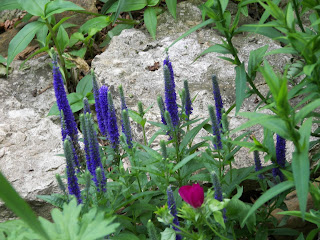The Pantone color of the year 2020 is my favorite! From light blue to dark blue - I love! love! love it!
And we always question what Pantone has to do with gardening: Although not so much with actual plants, you will see garden accessories in blues of all shades.
Although plants of all kinds come in shades of red, yellow, purples and white there aren't a great number of blue flowering or leafed plants. To date, there are no true blue daylilies. Even though hybridizers are trying so very hard, up to now they all have a bit of purple in the shade.
Blue flowering plants need to be featured with contrasting colors. Put a bunch of blue flowers against the dark green of evergreens and they may be very hard to distinguish. It's a bit of a waste.
Combine with white, yellow, chartreuse and lime, red, pink and orange and they'll enhance each other.
Here's a few of my favorite garden blues:
Colorado Blue Spruce. Although particular about where it grows, when it finds the right spot, it stunning.
Globe Thistle is an easy sweet plant that's not only blue beautiful, the bees and butterflies will cover the blooms.
Blue Day Flower (Spiderwort) is a wild little sweetie with a head that looks almost like an animal face. It will spread, is easy to pull and doesn't interfere with other plants. I leave enough to enjoy the blooms.
Veronica and salvia come in shades of blue to lavender blue. Some are perennial and others annual. Some annuals self seed. The spikes make a nice contrast to bushy plants.

A sweet little spring bulb "Squill" spreads easily but isn't invasive. This one is a striped version. Originally from Turkey, it's been in the USA since the early 1800s. It's lightly fragrant.
 And finally (although there are more blue colored species in nurseries) the well-known "Endless Summer" Hydrangea. According to the soil, it may be pink or this lovely blue. (Acidic for blue - alkaline for pink) Sometimes mine puts on pink, lavender and blue all on the same plant and sometimes on the same flower. It has personality!
And finally (although there are more blue colored species in nurseries) the well-known "Endless Summer" Hydrangea. According to the soil, it may be pink or this lovely blue. (Acidic for blue - alkaline for pink) Sometimes mine puts on pink, lavender and blue all on the same plant and sometimes on the same flower. It has personality!
Jump into a little classic blue this summer - it's fun.









No comments:
Post a Comment